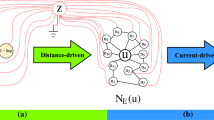Abstract
Graph representations have increasingly grown in popularity during the last years. Existing representation learning approaches explicitly encode network structure. Despite their good performance in downstream processes (e.g., node classification, link prediction), there is still room for improvement in different aspects, such as efficacy, visualization, and interpretability. In this paper, we propose, t-PINE, a method that addresses these limitations. Contrary to baseline methods, which generally learn explicit graph representations by solely using an adjacency matrix, t-PINE avails a multi-view information graph—the adjacency matrix represents the first view, and a nearest neighbor adjacency, computed over the node features, is the second view—in order to learn explicit and implicit node representations, using the Canonical Polyadic (a.k.a. CP) decomposition. We argue that the implicit and the explicit mapping from a higher-dimensional to a lower-dimensional vector space is the key to learn more useful, highly predictable, and gracefully interpretable representations. Having good interpretable representations provides a good guidance to understand how each view contributes to the representation learning process. In addition, it helps us to exclude unrelated dimensions. Extensive experiments show that t-PINE drastically outperforms baseline methods by up to 351.5% with respect to Micro-F1, in several multi-label classification problems, while it has high visualization and interpretability utility.





Similar content being viewed by others
References
Aivazoglou M, Roussos AO, Margaris D, Vassilakis C, Ioannidis S, Polakis J, Spiliotopoulos D (2020) A fine-grained social network recommender system. Soc Netw Anal Min 10(1):8
Azaouzi M, Rhouma D, Romdhane LB (2019) Community detection in large-scale social networks: state-of-the-art and future directions. Soc Netw Anal Min 9(1):23
Bhagat S, Cormode G, Muthukrishnan S (2011) Node classification in social networks. In: Social network data analytics. Springer, pp 115–148
Cao B, He L, Wei X, Xing M, Yu PS, Klumpp H, Leow AD (2017) t-BNE: tensor-based brain network embedding. In: Proceedings of the 2017 SIAM international conference on data mining. SIAM, pp 189–197
Carroll JD, Chang JJ (1970) Analysis of individual differences in multidimensional scaling via an n-way generalization of “eckart-youn” decomposition. Psychometrika 35(3):283–319
Derr T, Wang Z, Dacon J, Tang J (2020) Link and interaction polarity predictions in signed networks. Soc Netw Anal Min 10(1):1–14
Dhillon IS, Modha DS (2001) Concept decompositions for large sparse text data using clustering. Mach Learn 42(1–2):143–175
Easley D, Kleinberg J (2010) Networks, crowds, and markets: reasoning about a highly connected world. Cambridge University Press, Cambridge
Gong H, Bhat S, Viswanath P (2017) Tensor-based preposition representation
Goyal P, Ferrara E (2017) Graph embedding techniques, applications, and performance: a survey. arXiv preprint arXiv:1705.02801
Grover A, Leskovec J (2016) node2vec: Scalable feature learning for networks. In: Proceedings of the 22nd ACM SIGKDD international conference on knowledge discovery and data mining. ACM, pp 855–864
Hamilton W, Ying Z, Leskovec J (2017) Inductive representation learning on large graphs. In: Advances in neural information processing systems, pp 1024–1034
Kolda TG, Bader BW (2009) Tensor decompositions and applications. SIAM Rev 51(3):455–500
Liben-Nowell D, Kleinberg J (2007) The link-prediction problem for social networks. J Assoc Inf Sci Technol 58(7):1019–1031
Lu Q, Getoor L (2003) Link-based classification. In: Proceedings of the 20th international conference on machine learning (ICML-03), pp 496–503
Papalexakis EE, Faloutsos C, Sidiropoulos ND (2017) Tensors for data mining and data fusion: models, applications, and scalable algorithms. ACM Trans Intell Syst Technol (TIST) 8(2):16
Perozzi B, Al-Rfou R, Skiena S (2014) Deepwalk: Online learning of social representations. In: Proceedings of the 20th ACM SIGKDD international conference on Knowledge discovery and data mining. ACM, pp 701–710
Perozzi B, Kulkarni V, Skiena S (2016) Walklets: multiscale graph embeddings for interpretable network classification. arXiv preprint arXiv:1605.02115
Peterson LE (2009) K-nearest neighbor. Scholarpedia 4(2):1883
Rossi RA, Zhou R, Ahmed NK (2017) Deep feature learning for graphs. arXiv preprint arXiv:1704.08829
Smith S, Choi JW, Li J, Vuduc R, Park J, Liu X, Karypis G (2017) FROSTT: the formidable repository of open sparse tensors and tools. http://frostt.io/
Tang J, Qu M, Wang M, Zhang M, Yan J, Mei Q (2015) Line: Large-scale information network embedding. In: Proceedings of the 24th international conference on world wide web. ACM, pp 1067–1077
Van de Cruys T (2010) A non-negative tensor factorization model for selectional preference induction. Nat Lang Eng 16(4):417–437
Xie P (2017) Diversity-promoting and large-scale machine learning for healthcare. Ph.D. thesis, Carnegie Mellon University Pittsburgh
Yang C, Liu Z, Zhao D, Sun M, Chang EY (2015) Network representation learning with rich text information. In: IJCAI, pp 2111–2117
Yu X, Ren X, Sun Y, Gu Q, Sturt B, Khandelwal U, Norick B, Han J (2014) Personalized entity recommendation: a heterogeneous information network approach. In: Proceedings of the 7th ACM international conference on web search and data mining. ACM, pp 283–292
Zhao B, Sen P, Getoor L (2006) Event classification and relationship labeling in affiliation networks. In: Proceedings of the workshop on statistical network analysis (SNA) at the 23rd international conference on machine learning (ICML)
Author information
Authors and Affiliations
Corresponding author
Additional information
Publisher's Note
Springer Nature remains neutral with regard to jurisdictional claims in published maps and institutional affiliations.
Rights and permissions
About this article
Cite this article
Al-Sayouri, S., Gujral, E., Koutra, D. et al. t-PINE: tensor-based predictable and interpretable node embeddings. Soc. Netw. Anal. Min. 10, 46 (2020). https://doi.org/10.1007/s13278-020-00649-4
Received:
Revised:
Accepted:
Published:
DOI: https://doi.org/10.1007/s13278-020-00649-4




